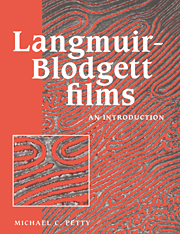Book contents
- Frontmatter
- Contents
- Preface
- Acknowledgements
- Notes for reference
- 1 The bulk phases of matter
- 2 Monolayers: two-dimensional phases
- 3 Film deposition
- 4 Monolayer materials
- 5 Structure of multilayer films
- 6 Electrical phenomena
- 7 Optical properties
- Appendices
- A Electronic energy levels in organic solids
- B Interaction of electromagnetic radiation with organic thin films
- C Crystallography
- Materials index
- Subject index
C - Crystallography
Published online by Cambridge University Press: 30 November 2009
- Frontmatter
- Contents
- Preface
- Acknowledgements
- Notes for reference
- 1 The bulk phases of matter
- 2 Monolayers: two-dimensional phases
- 3 Film deposition
- 4 Monolayer materials
- 5 Structure of multilayer films
- 6 Electrical phenomena
- 7 Optical properties
- Appendices
- A Electronic energy levels in organic solids
- B Interaction of electromagnetic radiation with organic thin films
- C Crystallography
- Materials index
- Subject index
Summary
The crystal lattice
An ideal crystal contains atoms arranged in a repetitive three-dimensional pattern. If each repeat unit of this pattern, which may be an atom or group of atoms, is taken as a point then a three-dimensional point lattice is created. A space lattice, such as that shown in figure C.1, is obtained when lines are drawn connecting the points of the point lattice. The space lattice is composed of box-like units, the dimensions of which are fixed by the distances between the points in the three noncoplanar directions x, y and z. These are known as unit cells and the crystal structure has a periodicity (based on the contents of these cells) represented by the translation of the original unit of pattern along the three directions x, y and z. These directions are called the crystallographic axes. Any directions may, in principle, be chosen as the crystallographic axes. However, it is useful to select a set of axes which bears a close resemblance to the symmetry of the crystal. This can result in x, y and z directions that are not at right angles to one another. In figure C.1, the angle between the y and z axes is designated α, between the z and x axes, β, and between the x and y axes, γ.
- Type
- Chapter
- Information
- Langmuir-Blodgett FilmsAn Introduction, pp. 222 - 226Publisher: Cambridge University PressPrint publication year: 1996



